View in other NatureServe Network Field Guides
NatureServe
Montana
Utah
Wyoming
Idaho
Wisconsin
British Columbia
South Carolina
Yukon
California
New York
Northern Grasshopper - Melanoplus borealis
Other Names:
Northern Spur-throat Grasshopper
General Description
The following comes from Brooks (1958), Vickery and Kevan (1985), Pfadt (2002), Capinera et al. (2004), and Scott (2010). A dark, medium sized grasshopper with wings (tegmina) of variable lengths, and void of any markings. A dark stripe extends from the back of the eye onto the lateral lobe of the pronotum. The outer surface of the hind femur is usually dark to black and the ventral area is usually red, but sometimes yellow. The hind tibia is red, sometimes yellow, with black spines.
Phenology
Northern Grasshopper eggs remain in the soil for 2 years and begin hatching in late spring to early summer. It is one of several grasshopper species to have a two-year life cycle. Adults occur from July to September (Pfadt 2002, Capinera et al. 2004, and Scott 2010).
Diagnostic Characteristics
The following is taken from Brooks (1958), Vickery and Kevan (1985), Pfadt (2002), Capinera et al. (2004), and Scott (2010). Body length to end of forewings for males is 15 to 21 mm, and females 17 to 26 mm. Wing (tegmina) lengths vary, female wings are usually short, extending over only three-quarters of the abdomen’s length. Male wings are generally longer, extending to or slightly beyond the abdomen tip.
Any number of Melanoplus species can be confused with this species without collecting male specimens for genitalia comparisons to make positive identifications. There are three subspecies (or forms) of the Northern Grasshopper: M.b. borealis, M.b. janius, and M.b. monticola. In Montana, our subspecies is M. borealis borealis.
Species Range
Montana Range
Range Descriptions
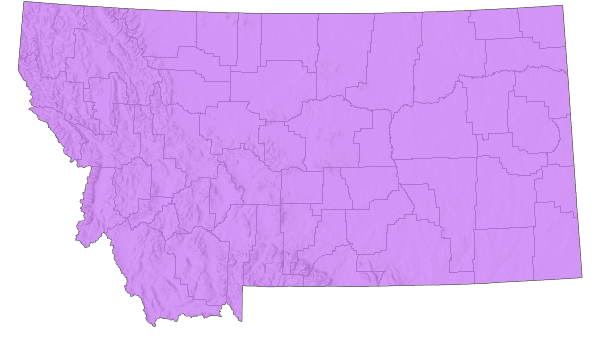
 Native
Native
Range Comments
Widely distributed across northern North America (hence its name), from Alaska across all the provinces of Canada. In the U.S. it ranges from the New England states, westward to the Rocky Mountain front, dipping southward into the Central states and Colorado. In Montana, it has been collected in 18 counties across the state (Brooks 1958, Pfadt 2002, Capinera et al. 2004, Scott 2010, Vickery and Kevan 1985).
Observations in Montana Natural Heritage Program Database
Number of Observations: 6
(Click on the following maps and charts to see full sized version)
Map Help and Descriptions
Relative Density
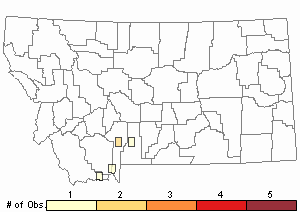
Recency
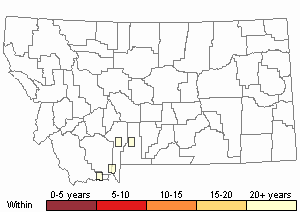
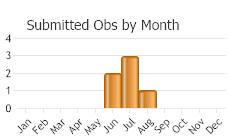
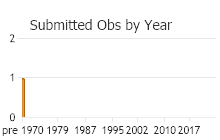 (Observations spanning multiple months or years are excluded from time charts)
(Observations spanning multiple months or years are excluded from time charts)
Habitat
The Northern Grasshopper inhabits both lowland and mountain habitats, which include arctic tundra, bogs, moist pastures, margins of streams and ponds, and moist mountain meadows. It occurs at nearly all altitudes and can often be the dominate species found at high altitudes (Vickery and Kevan 1985, Pfadt 2002, Capinera et al. 2004, Scott 2010).
Food Habits
This species feeds primarily on forbs, but sometimes on certain grasses. Favored food plants include lupines, locoweeds, dandelions, thistles, and cinquefoil. Preferred grasses include bluegrass,
western wheatgrass (
Elymus smithii), and
Idaho fescue (
Festuca idahoensis. They will also feed on other arthropods and dead or dying grasshoppers if they have an opportunity (Pfadt 2002).
Reproductive Characteristics
Upon hatching, nymphs pass through 5 instars, and molt into the adult stage in about 30 days, after which they become sexually mature within 3 weeks. Egg pods contain 12 to 16 eggs. There is currently no data relative to female oviposition in nature. Some studies have been made under laboratory rearing conditions (Pfadt 2002).
Management
In mountain meadows this species populations exhibit periodic outbreaks (population irruptions) which can have potential damage to rangeland forage and there have been some reports of “serious damage.” However, outbreak reports are inconclusive, as much is unknown about its population ecology. The pest status of this species is complex and it may also be “beneficial” as it feeds on its preferred host plants, lupine and loco (Pfadt 2002).
Stewardship Responsibility
References
- Literature Cited AboveLegend:
 View Online Publication
View Online Publication Brooks, A.R. 1958. Acridoidea of Southern Alberta, Saskatchewan, and Manitoba (Orthoptera). The Canadian Entomologist (Supplement 9) 90:5-92.
Brooks, A.R. 1958. Acridoidea of Southern Alberta, Saskatchewan, and Manitoba (Orthoptera). The Canadian Entomologist (Supplement 9) 90:5-92. Capinera, J.L., R.D. Scott, and T.J. Walker. 2004. Field Guide to Grasshoppers, Katydids, and Crickets of the United States. Ithaca, NY. Cornell University Press.
Capinera, J.L., R.D. Scott, and T.J. Walker. 2004. Field Guide to Grasshoppers, Katydids, and Crickets of the United States. Ithaca, NY. Cornell University Press. Pfadt, R.E. 2002. Field Guide to Common Western Grasshoppers, 3rd edition. Laramie, WY: Wyoming Agricultural Experiment Station, Bulletin 912, modified by S. Schell and S. Schell for electronic publication. Accessed 19 February 2020. http://www.uwyo.edu/entomology/grasshoppers/field-guide/index.html#fieldguidetoc
Pfadt, R.E. 2002. Field Guide to Common Western Grasshoppers, 3rd edition. Laramie, WY: Wyoming Agricultural Experiment Station, Bulletin 912, modified by S. Schell and S. Schell for electronic publication. Accessed 19 February 2020. http://www.uwyo.edu/entomology/grasshoppers/field-guide/index.html#fieldguidetoc Scott, R.D. 2010. Montana Grasshoppers, Katydids, and Crickets A Pictorial Field Guide to the Orthoptera. MagpieMTGraphics, Billings, MT.
Scott, R.D. 2010. Montana Grasshoppers, Katydids, and Crickets A Pictorial Field Guide to the Orthoptera. MagpieMTGraphics, Billings, MT. Vickery, V. R. and D. K. M. Kevan. 1985. The grasshopper, crickets, and related insects of Canada and adjacent regions. Biosystematics Research Institute, Ottawa, Ontario. Publication Number 1777. 918 pp.
Vickery, V. R. and D. K. M. Kevan. 1985. The grasshopper, crickets, and related insects of Canada and adjacent regions. Biosystematics Research Institute, Ottawa, Ontario. Publication Number 1777. 918 pp.
- Additional ReferencesLegend:
 View Online Publication
View Online Publication
Do you know of a citation we're missing? Bland, R.G. 2003. The Orthoptera of Michigan—Biology, Keys, and Descriptions of Grasshoppers, Katydids, and Crickets. East Lansing, MI: Michigan State University Extension, Bulletin E-2815. 221 p.
Bland, R.G. 2003. The Orthoptera of Michigan—Biology, Keys, and Descriptions of Grasshoppers, Katydids, and Crickets. East Lansing, MI: Michigan State University Extension, Bulletin E-2815. 221 p. Hebard, M. 1928. The Orthoptera of Montana. Proceedings of the Academy of Natural Sciences of Philadelphia, Vol. 80:211-306.
Hebard, M. 1928. The Orthoptera of Montana. Proceedings of the Academy of Natural Sciences of Philadelphia, Vol. 80:211-306. Hebard, M. 1932. Notes on Montana Orthoptera. Proceedings of the Academy of Natural Sciences of Philadelphia. V. 84. pp 251-257.
Hebard, M. 1932. Notes on Montana Orthoptera. Proceedings of the Academy of Natural Sciences of Philadelphia. V. 84. pp 251-257. Henry, J.E. 1969. Protozoan and viral pathogens of grasshoppers. Ph.D. Dissertation. Bozeman, MT: Montana State University. 153 p.
Henry, J.E. 1969. Protozoan and viral pathogens of grasshoppers. Ph.D. Dissertation. Bozeman, MT: Montana State University. 153 p. Kirk, K. and C.R. Bomar. 2005. Guide to the grasshoppers of Wisconsin. Madison, WI: Wisconsin Department of Natural Resources, Bureau of Integrated Science Services PUB-SS-1008. 154 p.
Kirk, K. and C.R. Bomar. 2005. Guide to the grasshoppers of Wisconsin. Madison, WI: Wisconsin Department of Natural Resources, Bureau of Integrated Science Services PUB-SS-1008. 154 p.
- Web Search Engines for Articles on "Northern Grasshopper"
- Additional Sources of Information Related to "Insects"





